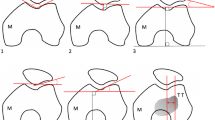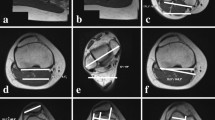Abstract
Purpose
This systematic review aimed to evaluate the variability of patellofemoral (PF) alignment and trochlear morphology in osteoarthritic knees.
Methods
PF alignment of the knee was defined by the following parameters: the sulcus angle (SA), femoral trochlear depth (FTD), patellar tilt angle (PTA), lateral patellofemoral angle (LPFA), lateral femoral trochlear inclination (LFTI) and tibial tubercle–trochlear groove distance (TT–TG). The electronic databases MEDLINE and EMBASE were searched from database inception to the search date (February 19, 2019) and were screened for relevant studies. The PRISMA guidelines were followed. Articles reporting PF alignment measurements of osteoarthritic knees in patients over 40 years old were included. Data were extracted and methodological quality was assessed using a 14-item checklist.
Results
A total of 8 studies met the inclusion criteria. The studies reported mean values ± SD between 120° and 141.1° ± 7.7 for the SA; 5.8 mm ± 1.4 for the FTD; between − 0.1° ± 3.3 and 10.3° ± 5.7 for the PTA; between 5.8° ± 5.4 and 17° for the LPFA; between 23.2° ± 5.0 and 27.1° ± 4.4 for the LFTI; and 5.8 mm ± 5.4 for the TT-TG.
Conclusion
PF alignment in the osteoarthritic knee is more variable than expected. This finding should encourage surgeons to consider the individual preoperative PF alignment more precisely with the aim of reducing anterior knee pain (AKP) after TKA. 3D-CT imaging might be of great value to analyse the PF alignment in an appropriate way.
Level of evidence
Level III.


Similar content being viewed by others
Abbreviations
- AKP:
-
Anterior knee pain
- FTD:
-
Femoral trochlear depth
- LFTI:
-
Lateral femoral trochlear inclination
- LPFA:
-
Lateral patellofemoral angle
- NA:
-
Not available
- PF:
-
Patellofemoral
- PTA:
-
Patellar tilt angle
- SA:
-
Sulcus angle
- SD:
-
Standard deviation
- TKA:
-
Total knee arthroplasty
- TT–TG:
-
Tibial tubercle–trochlear groove distance
References
Du Z, Chen S, Yan M, Yue B, Wang Y (2017) Differences between native and prosthetic knees in terms of cross-sectional morphology of the femoral trochlea: a study based on three-dimensional models and virtual total knee arthroplasty. BMC Musculoskelet Disord 18:1–8
Hochreiter B, Hirschmann MT, Amsler F, Behrend H (2018) Highly variable tibial tubercle-trochlear groove distance (TT-TG) in osteoarthritic knees should be considered when performing TKA. Knee Surg Sports Traumatol Arthrosc 27(5):1403–1409
Slevin O, Schmid FA, Schiapparelli FF, Rasch H, Amsler F, Hirschmann MT (2017) Coronal femoral TKA position significantly influences in vivo patellar loading in unresurfaced patellae after primary total knee arthroplasty. Knee Surg Sport Traumatol Arthrosc 25(11):3605–3610
Stephen JM, Lumpaopong P, Dodds AL, Williams A, Amis AA (2015) The effect of tibial tuberosity medialization and lateralization on patellofemoral joint kinematics, contact mechanics, and stability. Am J Sport Med 43(1):186–194
Drew BT, Redmond AC, Smith TO, Penny F, Conaghan PG (2016) Which patellofemoral joint imaging features are associated withpatellofemoral pain? Systematic review and meta-analysis. Osteoarthritis Cartil 24(2):224–236
Davies-Tuck M, Teichtahl AJ, Wluka AE, Wang Y, Urquhart DM, Cui J, Cicuttini FM (2008) Femoral sulcus angle and increased patella facet cartilage volume in an osteoarthritic population. Osteoarthritis Cartil 16(1):131–135
Drew BT, Bowes MA, Redmond AC, Dube B, Kingsbury SR, Conaghan PG (2017) Patellofemoral morphology is not related to pain using three-dimensional quantitative analysis in an older population: data from the osteoarthritis initiative. Rheumatology 56:2135–2144
Kalichman L, Zhu Y, Zhang Y, Niu J, Gale D et al (2007) The association between patella alignment and knee pain and function: an MRI study in persons with symptomatic knee osteoarthritis. Osteoarthritis Cartil 15(11):1235–1240
Macri EM, Felson DT, Zhang Y, Guermazi A, Roemer FW et al (2017) Patellofemoral morphology and alignment: reference values and dose–response patterns for the relation to MRI features of patellofemoral osteoarthritis. Osteoarthritis Cartil 25:1690–1697
Stefanik JJ, Roemer FW, Zumwalt AC, Zhu Y, Gross KD et al (2012) Association between measures of trochlear morphology and structural features of patellofemoral joint osteoarthritis on MRI: the MOST study. J Orthop Res 30(1):1–8
Stefanik JJ, Zumwalt AC, Segal NA, Lynch JA, Powers CM (2013) Association between measures of patella height, morphologic features of the trochlea, and patellofemoral joint alignment: the MOST study knee. Clin Orthop Relat Res 471(8):2641–2648
Tsavalas N, Katonis P, Karantanas AH (2012) Knee joint anterior malalignment and patellofemoral osteoarthritis: an MRI study. Eur Radiol 22(2):418–428
Widjajahakim R, Roux M, Jarraya M, Roemer FW, Neogi T et al (2017) Relationship of trochlear morphology and patellofemoral joint alignment to superolateral hoffa fat pad edema on MR images in individuals with or at risk for osteoarthritis of the knee: the MOST study. Radiology 284(3):806–814
Downs SH, Black N (1998) The feasibility of creating a checklist for the assessment of the methodological quality both of randomised and non-randomised studies of health care interventions. J Epidemiol Community Health 52:377–384
Langham S, Langham J, Goertz HP, Ratcliffe M (2011) Large-scale, prospective, observational studies in patients with psoriasis and psoriatic arthritis: a systematic and critical review. BMC Med Res Methodol 11:32
Mills K, Hunt MA, Ferber R (2013) Biomechanical deviations during level walking associated with knee osteoarthritis: a systematic review and meta-analysis. Arthritis Care Res 65:1643–1665
Deeks JJ, Dinnes J, D’Amico R, Sowden AJ, Sakarovitch C, Song F, Petticrew M, Altman DG (2003) Evaluating non-randomised intervention studies. Health Technol Assess 7:1–173
Sanderson S, Tatt ID, Higgins JPT (2007) Tools for assessing quality and susceptibility to bias in observational studies in epidemiology: a systematic review and annotated bibliography. Int J Epidemiol 36:666–676
von Elm E, Altman DG, Egger M, Pocock SJ, Gøtzsche PC, Vandenbroucke JP et al (2007) The strengthening the reporting of observational studies in epidemiology (STROBE) statement: guidelines for reporting observational studies. Lancet 370:1453–1457
Rathleff MS, Rathleff CR, Crossley KM, Barton CJ (2014) Is hip strength a risk factor for patellofemoral pain? A systematic review and meta-analysis. Br J Sports Med 48(14):1088
Hochreiter B, Hess S, Moser L, Hirschmann MT, Amsler F, Behrend H (2019) Healthy knees have a highly variable patellofemoral alignment: a systematic review. Knee Surg Sports Traumatol Arthrosc. https://doi.org/10.1007/s00167-019-05587-z
Werth L, Saffarini M, Amsler F, Abdelkafy A, Hirschmann MT (2017) The need for secondary resurfacing is affected by trochlear height in total knee arthroplasty. Knee Surg Sport Traumatol Arthrosc 25(12):3818–3823
Chen JY, Chin PL, Tay DKJ, Chia S-L, Lo NN, Yeo SJ (2015) Functional outcome and quality of life after patient-specific instrumentation in total knee arthroplasty. J Arthroplasty 30(10):1724–1728
Sassoon A, Nam D, Nunley R, Barrack R (2015) Systematic review of patient-specific instrumentation in total knee arthroplasty: new but not improved. Clin Orthop Relat Res 473(1):151–158
Hirschmann MT, Behrend H (2018) Functional knee phenotypes: a call for a more personalised and individualised approach to total knee arthroplasty? Knee Surg Sports Traumatol Arthrosc 26(10):2873–2874
Hirschmann MT, Konala P, Amsler F, Iranpour F, Friederich NF et al (2011) The position and orientation of total knee replacement components: a comparison of conventional radiographs, transverse 2D-CT slices and 3D-CT reconstrution. Bone Joint J 93(5):629–633
Shibanuma N, Sheehan FT, Stanhope SJ (2005) Limb positioning is critical for defining patellofemoral alignment and femoral shape. Clin Orthop Relat Res 434:198–206
Author information
Authors and Affiliations
Corresponding author
Ethics declarations
Conflict of interest
The authors declare that they have no conflict of interest.
Funding
No external funding was used.
Ethical approval
Ethical approval was not required, as this was a pure review of the literature that did not involve humans or animals.
Additional information
Publisher's Note
Springer Nature remains neutral with regard to jurisdictional claims in published maps and institutional affiliations.
Electronic supplementary material
Below is the link to the electronic supplementary material.
Rights and permissions
About this article
Cite this article
Hochreiter, B., Moser, L.B., Hess, S. et al. Osteoarthritic knees have a highly variable patellofemoral alignment: a systematic review. Knee Surg Sports Traumatol Arthrosc 29, 483–490 (2021). https://doi.org/10.1007/s00167-020-05928-3
Received:
Accepted:
Published:
Issue Date:
DOI: https://doi.org/10.1007/s00167-020-05928-3




